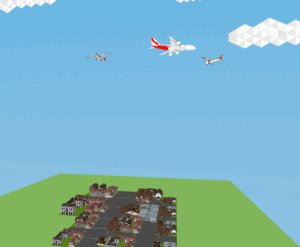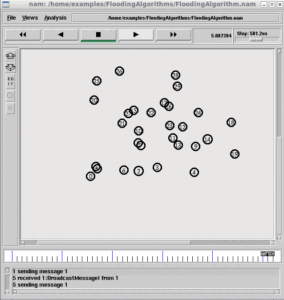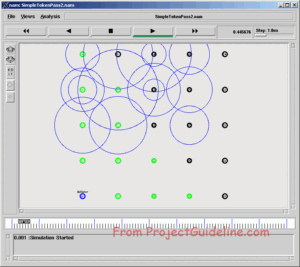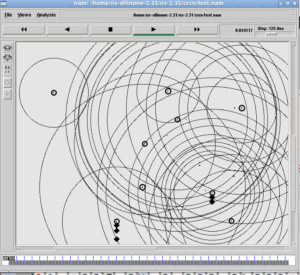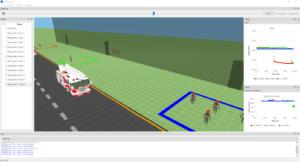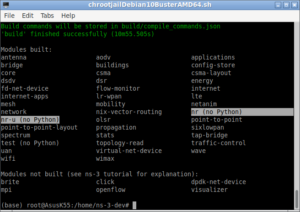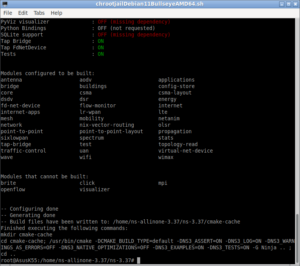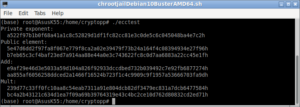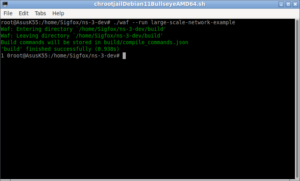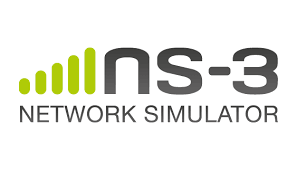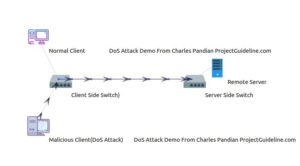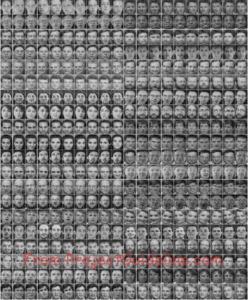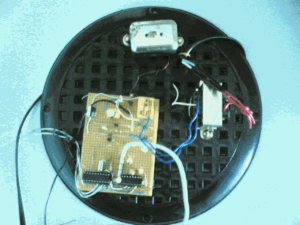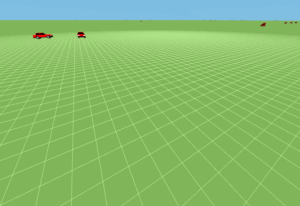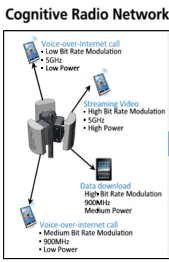1. Biased Markov Mobility Model.
It is based on the Markov Mobility model. Generally, the Markovian nature of mobility was used to mimic human mobility. This model can be used in wireless sensor network (WSN) Simulation and Mobile Adhoc Network (MANET) simulations.
Click on the following image to Play the Simulation of the Biased Markov Mobility Model.
2. Exponential Correlated Mobility Model.
The exponential Correlated Random Mobility Model is a group mobility model that uses a motion function to create movements. In this model, a motion function is used to create MN movements.
This model can be used in wireless sensor network (WSN) Simulation and Mobile Adhoc Network (MANET) simulations.
Click on the following image to Play the Simulation of Exponential Correlated Mobility Model
3.Freeway Mobility Model
This mobility model is with geographic restriction, where the movement of nodes is bounded by freeways (and streets or obstacles.). In a freeway, to avoid a collision, the speed of a vehicle cannot exceed the speed of the vehicle ahead of it. In the Freeway mobility model, the movement of the mobile node or vehicles is restricted to the pathway in the simulation field.
Freeway Mobility Model can be in the Vehicular Adhoc Network (VANET) as well as MANET simulations.
Click on the following image to Play the Simulation of the FreeWay Mobility Model.
4. Levy Walk Mobility Model
Levy walk is similar to a random walk, but its walk time (flight time) and pause time are more complex. The human walks performed in outdoor settings of tens of kilometres resemble a truncated form of Levy walks observed in animals. Levy walk mobility model is a versatile model for emulating diverse statistical patterns of human walks observed in some specific condition
This model can be used in wireless sensor network (WSN) Simulation and Mobile Adhoc Network (MANET) simulations.
Click on the following image to Play the Simulation of the FreeWay Mobility Model.
5. Manhattan Mobility Model
The Manhattan mobility model is a guide that leads the driver of a vehicle on the correct path. It is an urban-type of mobility model for vehicular ad-hoc networks (VANET). The Manhattan mobility model uses a “grid road topology. It works optimally where streets are situated in an organized manner. In this mobility model, mobile nodes move in the horizontal or vertical direction on an urban map. The Manhattan model employs a probabilistic approach in the selection of nodes movements since, at each intersection, a vehicle chooses to keep moving in the same direction. The probability of going straight is 0.5 and taking a left or right is 0.25 each.
The Manhattan model is not suitable for highway systems. Although this model provides flexibility for the nodes to change the direction, it imposes geographic restrictions on node mobility.
This model can be used in Vehicular Adhoc Network (VANET) Simulations and Mobile Adhoc Network (MANET) simulations.
Click on the following image to Play the Simulation of the Manhattan Mobility Model.
6. Markov Mobility Model
Generally, the Markovian nature of mobility was used to mimic human mobility. This model can be used in wireless sensor network (WSN) Simulation and Mobile Adhoc Network (MANET) simulations.
Click on the following image to Play the Simulation of the Markov Mobility Model.
7. Nomadic Mobility Model
In Nomadic Mobility Model, the mobile nodes tend to coordinate their movement with one another. One example of such mobility is that several soldiers may move together in a group. In the Nomadic model, each group has a centre, which is either a logical centre or a group leader node. The movement of the group leader determines the mobility behaviour of the entire group. Initially, each member of the group is uniformly distributed in the neighbourhood of the group leader. Subsequently, at each instant, each node has a speed and direction that is derived by randomly deviating from that of the group leader.
Click on the following image to Play the Simulation of Nomadic Mobility Model.
8.Probabilistic Random Walk Mobility Model
This mobility model utilizes a probability matrix to determine the position of a particular mobile node in the next time step, which is represented by three different states for position x and three different states for position y. State 0 represents the current (x or y) position of a given mobile node, state 1 represents the mobile node’s previous (x or y) position, and state 2 represents the mobile node’s next position if the mobile node continues to move in the same direction. A mobile node may take a step in any of the four possible directions (i.e., north, south, east, or west) as long as it continues to move. In addition, the probability of the mobile node continuing to follow the same direction is higher than the probability of the Mobile Node changing directions. Lastly, the values defined prohibit movements between the previous and next positions without passing through the current location. This implementation produces probabilistic rather than purely random movements, which may yield more realistic behaviours.
This model can be used in wireless sensor network (WSN) Simulation and Mobile Adhoc Network (MANET) simulations.
Click on the following image to Play the Simulation of Probabilistic Random Walk Mobility Model.
9. Pursue Mobility Model.
This model is based on the Reference Point Group model, but the group members pursue the leader like cops follow a thief.
This model can be used in wireless sensor network (WSN) Simulation and Mobile Adhoc Network (MANET) simulations.
Click on the following image to Play the Simulation of Probabilistic Pursue Mobility Model.
10. Random Direction Mobility Model
This model can overcome the non-uniform spatial distribution problem. Instead of selecting a random destination within the simulation field, in the Random Direction model, the node randomly and uniformly chooses a direction by which to move along until it reaches the boundary. After the node reaches the boundary of the simulation field it stops with a pause time T, then it randomly and uniformly chooses another direction to travel. This way, the nodes are uniformly distributed within the simulation field
This model can be used in wireless sensor network (WSN) Simulation and Mobile Adhoc Network (MANET) simulations.
Click on the following image to Play the Simulation of Random Direction Mobility Model.
11. Random Walk Mobility Model
The Random Walk model was originally proposed to emulate the unpredictable movement of particles in physics. It is also referred to as the Brownian Motion. Because some mobile nodes are believed to move unexpectedly, the Random Walk mobility model is proposed to mimic their movement behaviour. The Random Walk model has similarities with the Random Waypoint model because the node movement has strong randomness in both models. We can imagine the Random Walk model as the specific Random Waypoint model with zero pause time. However, in the Random Walk model, the nodes change their speed and direction at each time interval.
This model can be used in wireless sensor network (WSN) Simulation and Mobile Adhoc Network (MANET) simulations.
Click on the following image to Play the Simulation of the Random Walk Mobility Model.
12. Random Waypoint
The random waypoint model is a random model for the movement of mobile users, and how their location, velocity and acceleration change over time. Mobility models are used for simulation purposes when new network protocols are evaluated. It is one of the most popular mobility models to evaluate mobile ad hoc network (MANET) routing protocols, because of its simplicity and wide availability.
In random-based mobility simulation models, the mobile nodes move randomly and freely without restrictions. To be more specific, the destination, speed and direction are all chosen randomly and independently of other nodes. This kind of model has been used in many simulation studies.
Two variants, the random walk model and the random direction model are variants of the random waypoint model.
This model can be used in wireless sensor network (WSN) Simulation and Mobile Adhoc Network (MANET) simulations.
Click on the following image to Play the Simulation of the Random Waypoint Mobility Model.
13. Row Mobility Model
This model is based on the Reference Point Group Model (RPGM) model; however attempts to arrange the nodes in a row, near the leader of the group.
This model can be used in wireless sensor network (WSN) Simulation, Mobile Adhoc Network (MANET) simulations. This model can be used for simulating a body area network (BAN), also referred to as a wireless body area network (WBAN) or a body sensor network (BSN) or a medical body area network (MBAN), is a wireless network of wearable computing devices.
Click on the following image to Play the Simulation of Row Mobility Model.
14. String Mobility Model
The string model is based on the Reference Point Group Model (RPGM), but nodes make a line and follow the beforehand node movement. Thus, their movement will be like a string moving in the map.
This model can be used in a wireless sensor network (WSN) Simulation, and a body area network (BAN).
Click on the following image to Play the Simulation of String Mobility Model.

 Discuss Through WhatsApp
Discuss Through WhatsApp